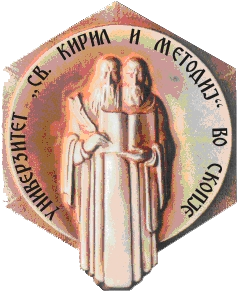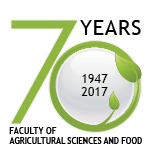Journal of Agricultural, Food and Environmental Sciences
Paper Submission
INTERNATIONAL SCIENTIFIC JOURNAL
JOURNAL OF AGRICULTURAL, FOOD AND ENVIRONMENTAL SCIENCES
The JAFES is an International scientific peerreviewed Open Access Journal published twice а yearly
Published by:
“Ss. Cyril and Methodius" University in Skopje,
Faculty of Agricultural sciences and food-Skopje
Advisory board
Еditor in Chief
Vjekoslav Tanaskovikj, Skopje, Macedonia
Kocho Porchu, Skopje, Macedonia
Associate Editor
Snezana Jovanovic, Belgrade, Serbia
Jovica Vasin, Novi Sad, Serbia
Radmila Stikić, Belgrade, Serbia
Biljana Škrbić, Novi Sad, Serbia
Ana Marjanovic Jeromel¸ Novi Sad, Serbia
Bojan Srdjević, Novi Sad, Serbia
Zoran Rajić, Belgrade, Serbia
Jasmina Havranek, Zagreb, Croatia
Mirjana Herak Ćustić, Zagreb, Croatia
Vlasta Piližota, Osijek, Croatia
Ivo Tursich, Zagreb, Croatia
Darko Vončina, Zagreb, Croatia
Zlatan Sarić, Sarajevo, B&H
Josip Ćolo, Sarajevo, B&H
Muhamed Brka, Sarajevo, B&H
Velibor Spalević, Podgorica, Montenegro
Bozidarka Marković, Podgorica, Montenegro
Nazim Gruda, Bonn, Germany
Venelin Roychev, Plovdiv, Bulgaria
Nasya Tomlekova, Plovdiv, Bulgaria
Irena Rogelj, Ljubljana, Slovenia
Drago Kompan, Ljubljana, Slovenia
Michael Murković, Graz, Austria
Hristaq Kume, Tirana, Albania
Sonja Srbinovska, Skopje, Macedonia
Marjan Kiprijanovski, Skopje, Macedonia
Marina Stojanova, Skopje, Macedonia
Biljana Kuzmanovska, Skopje, Macedonia
Mirjana Jankulovska, Skopje, Macedonia
Dragi Dimitrievski, Skopje, Macedonia
JOURNAL OF AGRICULTURAL, FOOD AND ENVIRONMENTAL SCIENCES
Address
(Editorial Board)
“Ss. Cyril and Methodius" University in Skopje
Faculty of Agricultural sciences and food-Skopje
P.O. Box 297, MK-1000 Skopje,
Republic of Macedonia
Email: jafes@fznh.ukim.edu.mk
About the journal
The JAFES is an International scientific peer-reviewed open access journal published twice a year. It retains a leading position in the publication of high quality original research, comparative studies and reviews in agriculture, food and environmental sciences. This journal provide good collaboration among scientists on international level by stimulating contacts and exchange of knowledge fostering scientific productivity.
Instructions for Authors
Manuscripts sent to the editorial board (e-mail address: jafes@fznh.ukim.edu.mk) should be prepared in Microsoft Word (Times New Roman font, 11 pt) and submitted in format 17 x 24 cm (File / Page setup / Paper / Width = 17 cm; Height = 24 cm), with single line spacing (Format / Paragraph / Line spacing = Single), 2 cm margins all around (File / Page setup / Margins / Top = 2 cm; Bottom = 2 cm; Left = 2 cm; Right = 2 cm), that is approximately 44 lines per page in this format.
Manuscripts are published in English. Papers that have been published elsewhere, in whole or extracts (excerpts) of their important findings, will not be accepted. A manuscript should not exceed 10 pages. Exceptions can be made if the content and quality of the paper justify it (at the discretion of the Editor).
Full research papers should include the following sections:
- Author/s name/s, Title
The author's name should be placed bellow the title and with the author's appellation and affiliation. Author(s) affiliation should indicated name and address of institution, including the e-mail address of the corresponding author.
Title should provide a concise but also an informative synthesis of the study (recommended not more than 100 characters including spaces).
- ABSTRACT (in English)
The Abstract, in English language, should provide basic data on the problem that was treated and the results obtained. It should be brief, preferably one paragraph only, up to 250 words, but sufficient to inform the reader of the character of the work, its results and its conclusions.
- Key words
Keywords should provide 4-6 words or compound words, suitable for an information retrieval system.
Main text of the manuscript includes the following sections:
- INTRODUCTION
The introduction should answer the questions what was studied, why was it an important question, what was known about it before and how the study will advance our knowledge.
- MATERIAL AND METHODS
Material and methods explain how the study was carried: description of the study site, including the significant physical and biological features, and the precise location (latitude and longitude, map, etc); the experimental or sampling design; the protocol for collecting data; how the data were analyzed. In this section also should be provided a clear description of instruments and equipment, machines, devices, chemicals, diagnostic kits, plants/animals studied, technology of growing/housing, sampling sites, software used etc.
- RESULTS followed by DISCUSSION
Results and Discussion may be combined into a single section (if appropriate) or it can be a separate section. The results objectively present key results, without interpretation, in an orderly and logical sequence using both text and illustrative materials (tables and figures).
The discussion interpret results in light of what was already known about the subject of the investigation, and explain new understanding of the problem after taking results into consideration.
The International System of Units (SI) should be used.
- CONCLUSIONS
The conclusion should present a clear and concise review of experiments and results obtained, with possible reference to the enclosures.
- ACKNOWLEDGMENTS
If received significant help in designing, or carrying out the work, or received materials from someone who did a favour by supplying them, their assistance must be acknowledged. Acknowledgments are always brief.
- REFERENCES (LITERATURE)
References should cover all papers cited in the text. The in-text citation format should be as follows: for one author (Markoski, 2011), for two authors (Hervik and Hayens 2011) and for more than two authors (Zhu et al. 2007). Use commas to separate multiple citations. Multiple citations should be ordered chronologically. In the case of publications in any language other than English, the original title should be retained.
More details in the Bibliographic style.
The literature section gives an alphabetical listing (by first author's last name) of the references.
Short communication should include the following sections:
- Title,
- Abstract,
- Key words,
- Main text,
- Acknowledgments,
- References,
- Tables and Figures with captions.
SUPPLY OF ARTWORK, PHOTOS: Diagrams and graphs should be provided as finished black and white line artwork or colour images. Electronic graphics included in your manuscript should be either inserted in the word document or as .gif or .jpg formats. Photos should be supplied un-screened in original form or in electronic form. All illustration (diagrams, graphs, tables, photos) must be fully captioned..
THE REVIEW PROCESS: Submitted manuscripts are reviewed anonymously by 2 international referees (duble blind reviews). All tracking of manuscripts and reviewers is done by the Editor. All attempts will be made to ensure submissions will be reviewed within three months after e-mail submission to the Editor. Manuscripts will be returned to the lead authors when each review is completed.
Bibliographic style
- All references must include: name of author(s), year of publication, title, place of publication and publisher (for books), journal title, volume and pages (for articles).
- The names of all authors of a work should be given in bibliographies.
- Where there are more than three authors in the bibliography, abbreviate to et al. in the text (but not in the bibliography).
- When an author has written more than one work in the same year, use a, b, etc. to differentiate, e.g. 2000a, 2000b.
- Entries by the same author/s should be listed in ascending chronological order.
- Use the ampersand(&) between the names of the last two authors in the bibliography but use and in the text.
- Titles of books, journals and periodicals are italicized (do not use inverted commas). Titles of articles and chapters are not italicized.
- Titles of papers presented at meetings and titles of theses are italicized. The type of thesis, e.g. M.Sc., Ph.D., is placed at the end of the reference, in parentheses, without a full stop,
e.g. Westergard, C. 2015. Farmland Valuation: A Net Present Value Approach Using Simulation. Kansas State University, Manhattan. (MA thesis)
- Titles of mimeographs are italicized, with the abbreviation mimeo placed at the end of the reference in parentheses, e.g. (mimeo)
· When the journal is cited the article title is in roman and lower case except for the initial capital letter. The journal title is italicized and with initial capital letters. Data are ordered as follows: volume number, (issue number in parentheses) followed by a colon and a space, page numbers.
e.g. Peralta, I.E. & Spooner, D. M. (2001): Granule – bound starch synthase (Gbssi) gene phylogeny of wild tomatoes (Solanum L. section Lycopersicon Mill. Wettst. subsection Lycopersicon). American Journal of Botany, 88(10): 1888-1902.
· When the book is cited the city (place of publication) comes before the publisher. When the city is the capital, the country is normally omitted. Note that in references United States and United Kingdom may be abbreviated to USA and UK. Note also that 200 pp. = 200 pages, whereas p. = page (singular). The first word of the book title takes an initial capital letter followed by lower-case initial letters (like the article title in the first example).
e.g. Bethke, C.L. (1993): Growing media. In J. W. White, editor. Geraniums IV, pp.3-23. Geneva, Ball Publishing, Illinois, USA.
- Following is an example of a reference to an Internet document:
e.g. Sanders, D.C. (1997): Vegetable crop irrigation. (available at http://aces.nmsu.edu/aes/irrigation/documents/vegetable-crop-irrigation.pdf)he



